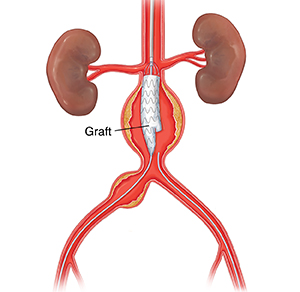Surgery for Abdominal Aortic Aneurysm
During surgery for abdominal aortic aneurysm (AAA), the weakened aortic wall is replaced with a hollow manmade tube (graft).
Reaching the aneurysm
The aorta can be reached through open surgery. Or a less invasive endovascular procedure may be done. Your surgeon will choose the best approach for you.
Open surgery
An incision is made in your abdomen. Once inside, your surgeon gently moves aside your organs to reach the damaged section of the aorta.
Endovascular procedure
Near your groin, the surgeon makes 2 small cuts (incisions). Then they thread a thin, flexible tube (catheter) into the artery at the incision. The surgeon places a graft inside the catheter and guides it toward the damaged part of the aorta.
Placing the graft
The goal is to safely route blood past the aneurysm.
During open surgery
Here is what to expect:
-
The aneurysm is opened and cleaned of any blood clots.
-
The graft is sewn to the aorta.
-
The wall of the aorta is wrapped around the graft to protect it. The wall is then sewn up.
-
The incision site is closed with stitches or staples.
 |
| During open surgery, a graft replaces the weakened section of aortic wall. The wall is wrapped around the graft. |
During an endovascular procedure
Here is what to expect:
-
Watching the catheter on a video monitor, the surgeon places a catheter in the best position. This position is confirmed by a dye study (angiogram).
-
The surgeon guides the graft through the catheter and expands it so blood can flow through it.
-
The blood is now re-routed through the graft and no longer fills the aneurysm.
-
The graft is attached inside the artery. It's held in place with metal springs (stents), hooks, or pins.
-
The catheter is removed. The incision sites are closed with stitches or staples.
 |
| During an endovascular procedure, a graft is inserted inside the aortic wall. The graft is then secured to the aorta above and below the aneurysm. |
Risks and possible complications
Here are potential problems to be aware of:
-
Infection
-
Blood clots in legs
-
Bleeding
-
Kidney failure
-
Respiratory failure
-
Injury to the colon’s blood supply
-
Erectile dysfunction
-
Spinal cord injury
-
Heart attack, stroke, or death
© 2000-2024 The StayWell Company, LLC. All rights reserved. This information is not intended as a substitute for professional medical care. Always follow your healthcare professional's instructions.